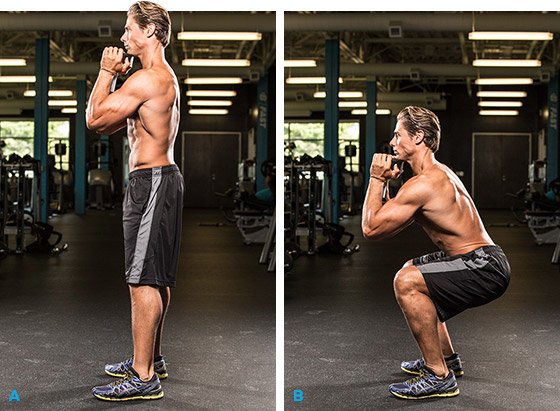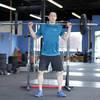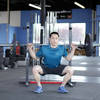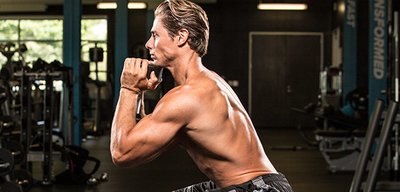When it's obvious you work out, friends—and even strangers—don't miss an opportunity to ask for advice. The most common questions I hear are: "How do I gain muscle?" and "How can I lose fat?"
Often, both questions come in the same breath.
More than one road leads to Rome—there are multiple ways to arrive at your destination, which in this case is to build muscle and get cut.
So let's take a look at one of my favorite ways to achieve both.
Train For Two Objectives
While the goals of building muscle and getting cut may appear unrelated, they're actually intertwined. Gaining muscle mass is all about training methods that affect the hormonal system, particularly testosterone and growth hormone, the body's two main anabolic (muscle-building) hormones.
The training methods that have been shown to increase testosterone levels in the body are those that:
- Use a large degree of muscle mass
- Are loaded heavily (above 85 percent of one-rep maximum)
- Use multiple sets and exercises to achieve a high workout training volume
- Follow short rest intervals of less than one minute1
Multiple sets with short rest intervals that elevate lactate levels also increase growth hormone release.[1]

Gaining muscle mass is all about training methods that affect the hormonal system, particularly testosterone and growth hormone, the body's two main anabolic (muscle-building) hormones.
While affecting the hormonal system is the main goal of training to increase muscle mass, affecting the metabolic rate is the focus of exercise for fat loss. The largest contributor to daily energy expenditure is your resting metabolic rate, and the only contributor to resting metabolic rate that you can control is your body composition. Increasing muscle mass increases your resting metabolic rate.[2]
I told you these two goals were interconnected!
While manipulating your resting metabolic rate has the greatest effect on caloric expenditure, exercise that temporarily increases your metabolism can aid in fat loss as well.[2] This acute change has two aspects. One is the increase in metabolism during exercise. The other is the elevation in energy expenditure after exercise needed to return your body to its resting state, which is known as excess post-exercise oxygen consumption, or EPOC. The greater the intensity of your workout, the greater the increase in metabolism both during and after exercise.[1]
One method in particular can be used to increase hormonal production and metabolism during and after exercise: high-load circuit training. It may sound like a sign on a chain link fence surrounding a power plant, but it involves three variables that are conducive to gains in muscle mass and the loss of fat mass: multiple exercises, high loads, and short rest intervals.
Let me explain how to best design a high-load circuit, and then I'll give a few examples that I like to use.
1. Exercise Selection
I have two rules for selecting exercises for this type of training. First, they have to be large multijoint mass movements, as this increases testosterone release while requiring a greater energy expenditure to perform.
Second, always choose the simplest version of a movement. This is a fast-paced workout that incites muscle fatigue, so any exercise that requires a lot of technical skill and form is less than ideal here.
Think squat jumps instead of Olympic lifts, trap bar deadlifts instead of traditional ones, and goblet squats as opposed to barbell squats. Save the technical lifts for lifting days with dedicated rest periods.
2. Number Of Exercises
Beginners should start with 3-5 different movements, and progress to as many as 8. Logistics can play a part in determining how many different exercises you do; don't be that person in the gym who takes it over with no regard for anyone else. Train during your gym's off-hours if necessary.
3. Exercise Split
For a greater increase of in-session metabolism, I prefer using full-body training sessions. Nonetheless, these methods can easily be split into upper and lower body or other body parts such as quads, back and arms one session and glutes, hamstrings, chest and shoulders the next.

Goblet Squat
4. Number Of Reps And Load
In my experience, doing 3-6 reps is the sweet spot for this type of training. As this is done in a circuit fashion with incomplete rest, you'll be unable to perform the same loads as during traditional lifting sessions.
So instead of choosing your 6RM (that is, a weight that's about 80 percent of your one-rep max), I suggest subtracting an extra 5-10 percent, so you'd instead be doing 70-75 percent of your 1RM.
That equates to choosing a weight you can do for about 10 reps, but again do only 5. Be somewhat conservative: You can always increase the load.
5. Number Of Sets And Rest Intervals
Here's where things get fun. Just like the number of reps, 3-6 sets is the best range of volume for this training method. If you like your workouts paced like clockwork, take 30-60 seconds rest between each exercise. Alternatively, wear a heart-rate monitor and rest until your heart reaches the anaerobic threshold (if you know it) or down to approximately a 150-160 beats. Or, with workouts that switch body areas, just push through the circuit, resting only as needed.

If you like your workouts paced like clockwork, take 30-60 seconds rest between each exercise.
This brings me to another approach to prescribing the number of sets. High-load circuit training can be applied to what are called "escalating density workouts." These sessions are performed for time as opposed to an established number of sets. You simply perform as much as you can within the timeframe (thus increasing the density of the workout), resting when needed.
For high-load circuit training, I usually time my sets between 8-15 minutes, depending on the number of exercises (more exercises equals more time).
6. Frequency
These training variables are great at expending energy and increasing anabolic hormone release. However, the catabolic hormone cortisol is also increased as a result of large muscle mass and high-intensity, low-rest interval training. While these elevated levels of cortisol are essential in the short term for muscle gain and tissue repair, chronically high levels will decrease protein synthesis and lead to decreased immune function. In other words, say goodbye to muscle mass and hello to illness.
Exercise caution with this style of exercise. I suggest 1-2 of these workouts per week with 1-2 other traditional lifting days, and the other days filled with lower-intensity training.
Two High-Load Circuits
1. Traditional Weight Circuit
- Try and do all six exercises as a circuit, resting no more than 30 seconds between exercises. If that's not possible, try and do all the exercises with dumbbells or kettlebells in a small area.
- Choose a weight that's about 75 percent of your max weight, or the weight you can just do for 10 reps (your 10RM), but do only five reps.
- Repeat the circuit a total of five times.
- With underhand-grip chin-ups, add weight or use an assisted machine as needed.
- For the push-ups, use a weighted vest or have a partner place a plate or two across your back.
- The suspension row is usually done with TRX straps or rings, but could alternately be done as a bent-over barbell row. The TRX movement is not done with an added load.

BodyFit
$6.99/month- 2,500+ expert-created single workouts
- 3,500+ how-to exercise videos
- Detailed workout instruction
- Step-by-step workout tips
- Training at gym or at home
- Access to Workout Plans
- Access to Bodyfit App
- Store Discounts
Already have a Bodybuilding.com account with BodyFit? Sign In

What comes with BodyFit?

- Instructional Videos
Don't risk doing a workout improperly! Avoid injury and keep your form in check with in-depth instructional videos.

- How-to Images
View our enormous library of workout photos and see exactly how each exercise should be done before you give it a shot.

- Step-by-Step Instructions
Quickly read through our step-by-step directions to ensure you're doing each workout correctly the first time, every time.
2. The Big Tuna Circuit
(Named after the most demanding coach I ever played for.)
- Perform as many rounds in 12 minutes as possible, rest five minutes, and repeat for another 12 minutes. Use a kettlebell or dumbbells.
- Select a weight that's 60-70 percent of your 1RM. Do just six reps.
- Do the exercises in a circuit, resting 30 seconds between movements.



BodyFit
$6.99/month- 2,500+ expert-created single workouts
- 3,500+ how-to exercise videos
- Detailed workout instruction
- Step-by-step workout tips
- Training at gym or at home
- Access to Workout Plans
- Access to Bodyfit App
- Store Discounts
Already have a Bodybuilding.com account with BodyFit? Sign In

What comes with BodyFit?

- Instructional Videos
Don't risk doing a workout improperly! Avoid injury and keep your form in check with in-depth instructional videos.

- How-to Images
View our enormous library of workout photos and see exactly how each exercise should be done before you give it a shot.

- Step-by-Step Instructions
Quickly read through our step-by-step directions to ensure you're doing each workout correctly the first time, every time.
References
- Baechle, T., & Earle, R. (2008). Essentials of strength training and conditioning (3rd ed.). Champaign, IL: Human Kinetics.
- Stiegler, P., & Cunliffe, A. (2006). The Role Of Diet And Exercise For The Maintenance Of Fat-Free Mass And Resting Metabolic Rate During Weight Loss. Sports Medicine, 36, 239-262.




